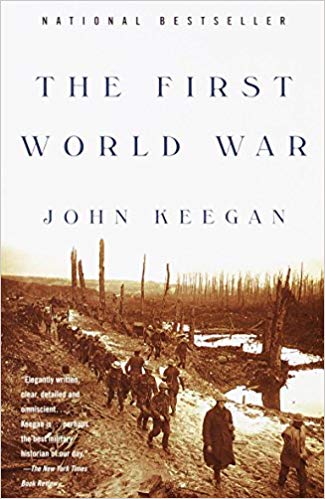
John Keegan is an eminent British military historian. He was for many years the senior lecturer in Military History at the Royal Military Academy, Sandhurst. He has been a Fellow of Princeton University and Professor of History at Vassar. Since 1998 a Reith Lecturer, he works as Defence Correspondent for the Daily Telegraph. Among his numerous books is The Second World War.
In the First World War, 2 million Germans, 1.7 million Russians and 1.7 million French, 1.5 million men of the Austrian-Hungarian Empire, 1 million British and 114,000 American servicemen were killed. In total 9 million men died. In his book The First World War, John Keegan examines the events and politics that lead to the war, analyzes the strategies of the powers involved as well as the operational developments (Amazon.com).
The outbreak of war was by no means final for Keegan. Common sense and good will could have stopped the conflict before fighting started. Nationalistic fervor and hatred, rigid military plans and ambitions as well as the absence of “a permanent medium of negotiation between the European powers” led to years of unnecessary slaughter.
Keegan finds harsh remarks for the German Kaiser and his generals and their political and military plans, but he does not hold the German military leaders responsable for the millions of men killed since they did not intend to fight this type of war. In fact, they thought they would be able to gain a rapid victory. Keegan also critizes leading Allied men such as General Douglas Haig (in his case, regarding the operational level). The author describes the shocking contrast between the lifestyle of a lot of generals and the one of common soldiers in the trenches.
Keegan comes to the conclusion that the generals were trapped within a technology gap. New technology allowed them mass destruction of life by means of artillery and machine guns and new machines such as the tank, the submarine and the airplaine, but was “inadequate to restore to them the flexibilities of control that would have kept destruction of life within bearable limits.” In fact, not only was the cavalry still riding and soldiers wearing outdated uniforms, but communication was still established by runners and pigeons on land and by signal flags at sea! There was no telephone or radio. The officers did not know whether their artillery had destroyed its targets, they even did not know where to aim it.
The bibliography is too short but well structured. The photographic material could be more revealing with regard to the horrors of war, especially in the trenches. Overall, a good account in British perspective – the First World War was “the greatest loss of life in British military history”. “The Somme marked the end of an age of vital optimism in British life that has never been recovered.” By the way, some British people still hate “the Germans” more for WWI than for WWII. But of course the decline of British military power and economy has a lot of other, more important reasons.
Keegan tells us why and how the war started, how military operations were carried out and what impact the fighting had on people in general, not only on the soldiers. His remarks on the consequences of the war are too short and too weak. The history of the 20th century has its roots in the First World War, including Hitler, Germany and Austria, Russian and the Turkish revolutions, French and Polish politics. A peace more in the sense of American President Wilson’s intentions would have changed the course of history.

John Keegan: The First World War. Order the book from Amazon.com.